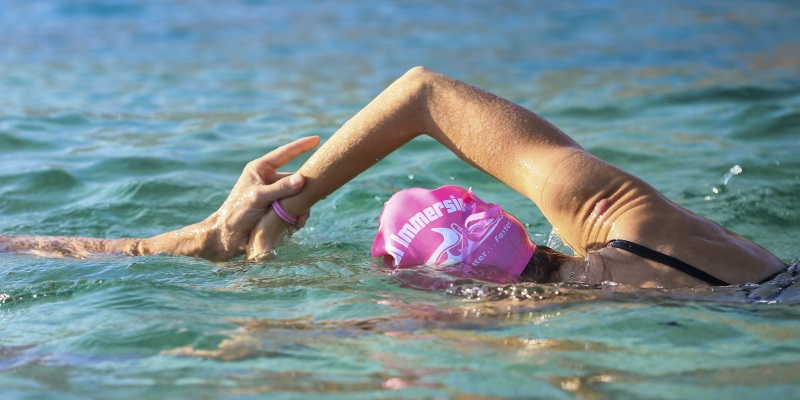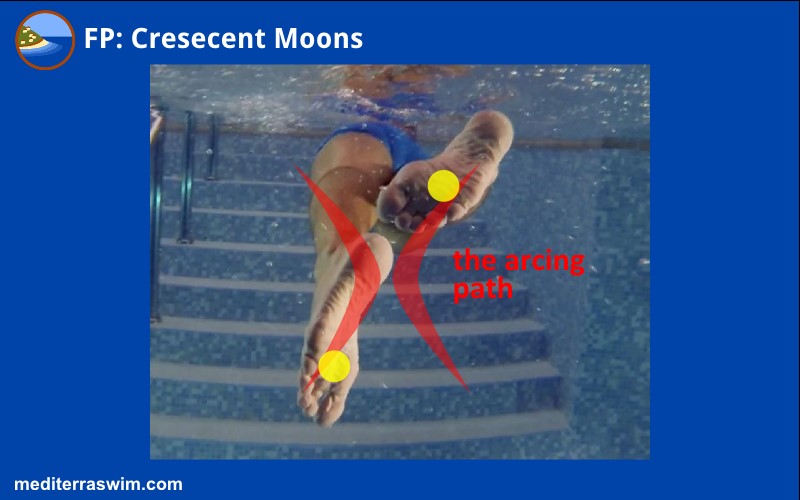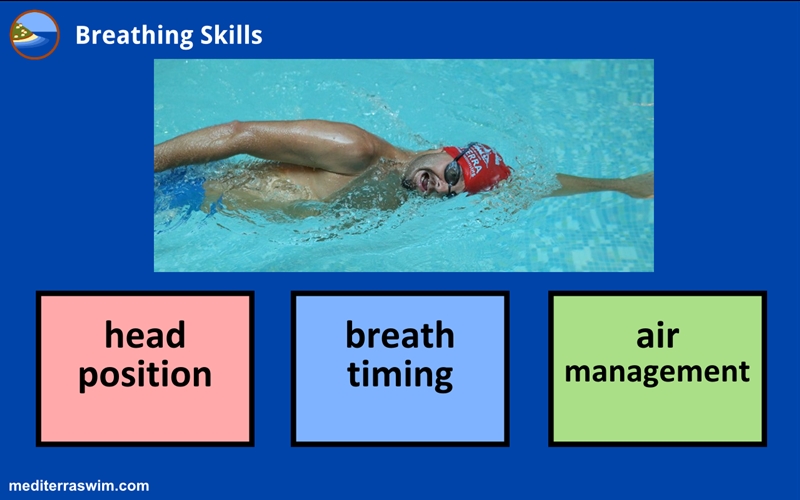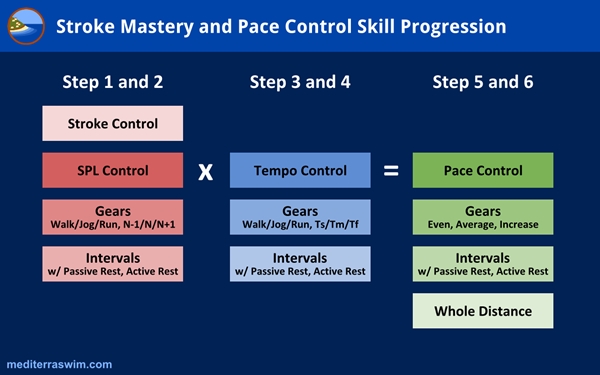by Mat Hudson | Aug 11, 2019 | Breathing, Freestyle, Level 1, Pool, Practice Example
This is a practice I designed for a swimmer who is doing very well with technique but is having some challenges with training his exhale from nose and inhale from mouth, keeping the airways clear of water. In order to not let the breathing troubles restrict his fitness development we use a combination of snorkel and no-snorkel swimming, to start with no breathing challenge and gradually add complexity over the course of the practice.
4x 50 warm up with gentle movements
Swim 3 rounds of 4 cycles of (2x 25 and 1x 50) with short rest between repeats
Each cycle use a different focal point:
- Neutral head, consistent depth breaking the surface
- Fully extend into skate
- Hip drives extension
- Hip pulls catch
Each round increase the complexity:
- R1 snorkel plus tempo at 1.50
- R2 snorkel plus tempo at 1.40
- R3 rhythmic breathing with tempo at 1.40
by Mat Hudson | Jul 25, 2018 | How To Train, Level 1, Pool, Practice Example, Progression, Stroke Length (SL)
Once you come into the TI training world, you realize that stroke count (stroke length) is an important indicator your improvement in efficiency (but not the only).
You may wonder what stroke count you should be using.
You may wonder how to make your stroke count lower.
You may wonder why this is so important!
I’ve added this article to the library to give you an argument for working on A Longer Stronger Stroke.
If this raises any questions for you, I would be glad to answer those for you or point you to the articles or posts we already have on that topic.
by Mat Hudson | Apr 19, 2018 | Entry, Freestyle, Level 1
One of our Dojo swimmers received a video analysis report recently, and one of the improvement opportunities I gave him was to make his entry closer to the shoulder. He was ready to accept this but still wondered why this was more advantageous than extending a bit farther over the surface like he sees so many swimmers do, even TI swimmers like Coach Terry in some of the videos. After writing my response I realized more of you might appreciate an answer too so I will share it here..
On the freestyle stroke, why have the hand enter closer to shoulder?

Good question, and I am glad you don’t accept the correction without understanding why.
There is a tendency for all of us to extend over the surface too far, and the faster the tempo, the more momentum and the farther that arm wants to extend before entering.
But the purpose for the arm entering sooner is that we want to deliver rotational force into the water through the extending arm as soon as streamline permits (as soon as we can shape the body into streamline to get more distance per stroke), because we need all that power to help part water molecules ahead, where our body needs to go. We have no need of parting air molecules since the body travels under water, not above.
As you observed in some videos, you will see this entry point creeping forward in any of us. But rather than a trait to imitate, it is a trait we want to resist.
It is a similar situation in breathing: we must discipline ourselves to turn the head to air and return as soon as possible, because the tendency is for us to get lazy (especially when feeling fatigued) and turn later, stay longer which ends up causing more problems. Though we see faces just beginning to touch air as the recovery arm comes out, and then see their arm go over their own goggles, this is something we want to avoid, not imitate.
In the entry, letting the arm extend above the surface is a ‘lazy’ action. When the body starts to feel fatigue the brain wants to shift its priority to energy conservation and it will pull resources away from actions that make more effective forward propulsion – in this case, it would rather extend in the air where it is easy on the arm, but extending in the water is the work that must continue if we want to make forward motion easier. Extending through air is easy… and ineffective at cutting that low-pressure path through the water for the rest of the body to slide through. This is one of the points in the stroke cycle where we must exercise great discipline to maintain optimal form, before and especially during fatigue.
At faster and faster tempos that arm will want to swing farther and farther forward – it has more momentum – but we should aim to resist and minimize this forward creep of the entry location.
by Mat Hudson | Feb 5, 2017 | Breathing, Catch, Freestyle, How To Train, Kick, Level 1, Priorities
I should address this concern I have heard from several lately when working on breathing skills…
You start investing your practice time on breathing skills and you notice other skills (like kick, recovery, and catch) that still require your focus seem to degrade. You know you can’t focus on everything at once, but it is frustrating to watch those other things fall apart while you turn your attention this way. So how do you work on breathing but not lose ground in those other areas?
First, fixing breathing is priority because poor breathing causes so many problems with energy waste, stress, and takes up mental/emotional space. If you have problematic breathing, it is lowering your ability to work on any other area. Get this breathing puzzle solved (or at least greatly improved) and you free up so many more resources to use when you go back to work on the other skills.
Second, easier breathing is totally dependent on your most fundamental freestyle skills – you must pay attention and work on the most important features of your body position and movement patterns in order to make breathing better – all those fundamental skills we work on in Superman, Skate and Recovery drills. So, the most essential pieces of your body control are going to be protected and improved when you do thorough work on breathing.
This then puts those ‘other’ skills that you are worried about into a different category – other skills like kick, recovery, and catch are advanced skills that are also dependent on that same foundation. You may not be able to focus on the kick or the catch while working on breathing, and you may feel that those suffer because of it. But you are keeping the foundation for everything tuned, and likely any improvements on the foundation which benefit breathing will also directly benefit the other advanced skills as well. It’s a win-win.
Bottom line – you’ve felt motivated to work on breathing right now by some high price you’ve paid for having inferior breathing. There is a good reason you are focusing on this right now and not something else. You’ve just got to focus on this at this moment and set aside concern for any other advanced skills – you can work on those next, once you acquire improvement in this breathing section first. And that work on other advanced skills will be easier because you can breathe easier.
First things first.
One thing at a time, in sequence of priority.
~ ~ ~

by Mat Hudson | Feb 4, 2017 | Freestyle, Kick, Level 1

Some of you have been drawn to develop your 2 Beat Kick lately.
I would like to call your attention to some resources that may help you.
First, if you are new to this kicking style called the 2 Beat Kick, then you may first want to view some of our stroke demonstrations on the Video Tutorials page. In any video where you see me swimming whole stroke you will see a 2-Beat Kick behind me.

It would be important that you first understand how the 2 Beat Kick is different from other styles of the flutter kick (namely, the 6-Beat and the 4-Beat kick). Then, you may learn why we prefer this style for most of our swimming purposes, and then to learn how to acquire it.
Please start by reading this article 2BK Defense, which will provide some additional links to the remaining articles on learning the 2BK.
And then you may go back to the Video Tutorials page and study the 2BK drill videos there which show you the various exercises we teach to help you train your brain and legs to prefer this kick pattern.
Then you may want to check out the 2 Beat Kick section on the 101 Focal Points page.
Enjoy, and let me know how it goes!

by Mat Hudson | Jan 25, 2017 | Breathing, Intensity, Level 1, Tempo

Let’s continue the discussion on how to solve breathing problems…
Solution: Improve Technique
Among those reading this post it may be readily understood how improving your body control and your breathing technique will make breathing easier – investing time and effort into those will:
- Increase economy through technical control – you simply won’t require as much air exchange to do the same amount of work.
- It is easier to get to air and get sufficient exchange.
That takes care of a great deal of the complaints swimmers have with breathing.

Solution: Improve Timing
It gets a bit more complicated when we try to think about the math behind this, but you can adjust these variables to find a better breathing pattern:
- increase stroke tempo – the frequency at which breathing windows come along
- change your breathing pattern so that there is less average time between breaths over a full length
- use smaller exhales, smaller inhales
- reduce the amount of pressure or effort per stroke
Like using a smaller gear (faster cadence) on a bicycle, you can speed up the tempo while reducing the pressure per stroke, then insert a breath every 3 strokes. You may find this easier than using a slow tempo, keeping as much pressure per stroke and inserting a breath every 2 strokes. Once you add up the amount of effort and the frequency of breaths over the length you may find that a shorter stroke at higher tempo, with more frequent-but-smaller breaths are more comfortable to maintain.
With those four variables you have a lot of room to experiment in finding a more sustainable stroke+breathing pattern for each event.
Solution: Higher Intensity Training
There is no way around it – we can work on perfecting technique forever but at some point we’ve got to increase effort and add power in order to go farther and go faster. (I spent a good portion of Smooth Strokes blog space over the last year explaining this).
Let’s say you and your TI Coach feel you’re stroke is quite economical at short distances, yet you start to feel breathless at around 150 meters. What’s going on? You may have reached the end of ‘Easy Speed’ benefits your early TI training provided you.
You will only increase your comfort for swimming beyond 150 meters by swimming into the discomfort past 150 meters and training there. Like the burn of good stretching in order to lengthen those tissues, you have to swim into that burn of breathlessness and muscle fatigue in order for your body to be provoked to adapt to it. There is just no other way to adapt your metabolism and muscles to longer distances.
As a matter of fact, the science of fitness behind aging is pointing us to the reality that increasing and then maintaining fitness longer in life is directly dependent on our dosage of high intensity training ( high intensity = uncomfortable in terms of breathing and heart rate and muscle burn).
So, to expand your comfortable swimming distance and speed – no matter how fine your technical control is – you have to swim into the uncomfortable zone to do it. And further more, the more you avoid discomfort (of this kind), the faster your comfort zone will shrink with age. That’s the hard word I am hearing from the experts on aging and fitness these days.
Solution: Become Comfortable With Discomfort
There is eu-stress (positive stress on the body) and dis-stress (negative stress on the body).
One one hand we are training to listen carefully to the body in order to remove unnecessary stress and strain, to make things flow better, make things feel better.
One the other hand, there are many strong sensations that are unavoidably present when you work your body at higher intensity or over longer distances. They are normal and they are healthy. Rather than label these as ‘unpleasant’ it is possible to retrain your brain so that they are regarded as positive sensations rather than negative, so that you associate them with good things rather than danger.
For those who are unaccustomed to high/long intensity efforts, in the early stages of a swim – especially when you have started out too hard – when these uncomfortable sensations are building up, this can trigger some anxiety or fear. The brain mistakenly worries that if those sensations keep building and building like that, surely the body is going to explode! But in fact, those sensations may just rise to a certain level and, if you keep the same effort level, those won’t actually increase. And, if you concentrate on focal points which restore your economy, after 300 or so meters it will start to feel easier again.
Essentially, this is the intended effect of a good warm up and the reason we emphasize doing it with quality every practice, every swim.
Just be aware that some amount of the breathlessness is appropriate – it’s the normal state you’ll be in when working at higher speeds or longer duration, and you can not only get used to it, but come to like it.
Conclusion
It will be good to invest in all four solutions:
- Lower your demand for air exchange with better technical control
- Use a pattern which provides smaller-but-more-frequent breaths
- Insert higher intensity training into your weekly plan
- Reinterpret the sensations that come with healthy higher intensity work
~ ~ ~
by Mat Hudson | Nov 7, 2016 | How To Train, Level 1, Level 2, Progression
What should your improvement expectation be for each Step in the skill progression?
Stage 1 – It Gets Easier
Generally, the benefits of Step 1 – Stroke Control skills – will be that you are able to swim a lot easier at your normal distances.
Why? With fundamental TI skills in place the energy demands and strain in the body will decrease a lot compared to your old land-mammal-style swimming.
This may not immediately translate into swimming farther or faster. Some people with such poor body shape and movement patterns may see a dramatic increase in speed because they were moving so slow before and totally exhausted by it. Those who were moving at a decent speed but under a great deal of effort, will more likely discover how to relax and produce that same speed with a lot less effort (this was what I experienced at first with TI). Meanwhile, there may be some basic fitness conditioning that needs to develop to support this new kind of body control before it can handle much longer distances. Enough power is available, but the swimmer can’t deliver it very well yet.
Stage 2 – Go Farther
The benefits of working in Step 2 and 3 – Stroke Length and Tempo skills – will be that you are eagerly able to swim farther with the same effort. Ability hold good shape and get consistent distance out of each stroke, and make those strokes on a consistent tempo will save energy and make it physically and mentally attractive to go farther. But this may not immediately translate into a major increase in speed either.
Stage 3 – Go Faster
The benefits of working in Step 4, 5 and 6 is that you will be able to swim faster under control.
The previous steps in the sequence (1,2,3) showed you how to quit wasting energy, how to save it and distribute it better to get more distance.
The reality of these advanced steps for speed (4,5,6) is that you are going to now have to put in more physical effort to match your mental concentration. Your strength is going to be challenged to grow parallel to your technique. The physics of human swimming dictates that we can get up to a certain speed in the early stages of TI training simply by reducing energy waste through superior body control – we might call this the Easy Speed Threshold. After that magical point we can only get faster by increasing power.
The critical thing to understand is this – and this a central point in TI training – that increased power can be applied effectively or applied wastefully, depending on the quality of your technique and how deeply it is imprinted. That instinct for quality is what Steps 1, 2 and 3 are meant to burn into your neuro-muscular system and into your training value system before you get to the pressure of increased power demands in Steps 4,5 and 6.
If there is a weakness in the TI training resources I think it would be found here – that the books and videos and most of the live training is focused on Step 1 and Step 2 skills – of course, this is what 80% of the swimmers of the world need right now. Yet people read, watch, or attend a training event and assume they have learned all they need to know about TI – or perhaps the instructor gave the impression that this is all they need to know. Not even close – this is just the beginning. This gap of understanding is what our online coaching service is trying to fill.
So my final question for you, my swimming friend…
What step do you feel you are at, and what should improvement for you looks like at this step?
by Mat Hudson | Nov 7, 2016 | How To Train, Level 1, Level 2, Progression
Here is a question for you…
If you faithfully follow the TI freestyle drill sequence, use focal points well, mix it in with your whole stroke swimming, and take your time to master every piece – will you eventually turn into a faster swimmer?
Or, in terms of our organized sequence of Level 1 and Level 2 skills, if you work a long time at Level 1 until you feel like you can perform every body position and stroke control detail well, will you automatically become a faster swimmer? (I suspect this disappointed swimmer practiced a lot at Level 1 and yet expected a Level 2 result.)
Short answer: No. You won’t necessarily get faster. Because Step 1 is about learning how to form and control the stroke. In this step you are just discovering how to align the body and adjust the stroke using all the various control points. Step 2 and 3 are showing you what to do with that stroke control to set up the conditions for increased speed – basic stroke length and tempo skills. Steps 4, 5 and 6 are where you learn to produce speed upon that foundation.

Learning how to pull on levers, push buttons and turn dials on the dashboard of an race car will not qualify you to race that car, no matter how many months you sit there and tinker with the dashboard. You’ve got to take that car onto the track and learn how to make the vehicle do things (faster!) with those levers, buttons and dials. You need to drive the car on a real track, under real conditions.

This chart shows how we break down the skill progression. The swimmer only get to the results of Step 5 and 6 by first going through Steps 1 to 4.
So too, with your own stroke in Step 1, you’ve been learning how to notice and adjust little details in your body position and stroke control. This is just the beginning. You are going to need to take that skill and put it to practice on gradually increasing challenges using the variables of Stroke Length and Tempo and Distance to create that increase in challenge. By doing this, your fitness (ability to generate power) will develop in parallel with your technique (ability to apply power with precision, where it is needed).
Those two – fitness and technique – are inseparable in training because all movement patterns are training the neuro-muscular system –teaching the body where and how to deliver power while you generate it. So, if you are going to do any movement to build power for swimming, you need to train the precision of movement to go with it at the same time. That is a core principle in TI training.







